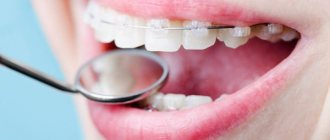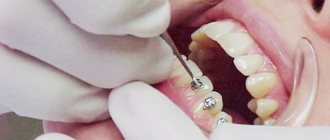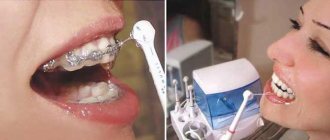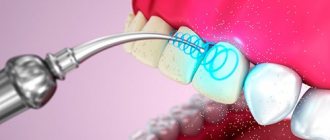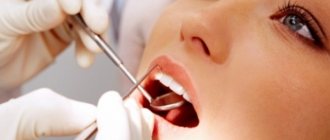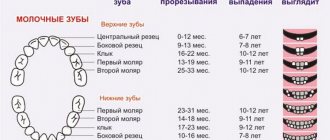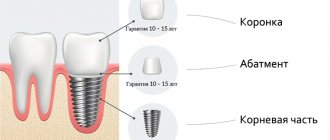When are braces removed?
After installation of the system, the patient visits the orthodontist at least once a month. The doctor adjusts the effects of braces and monitors the effectiveness of therapy. When the planned result is achieved and the risk of relapse is unlikely, the orthodontist will notify the patient that the correction phase has ended. During the next visit, he assigns the patient a day to remove braces, explains the stages of preparation and describes the procedure itself.
The duration of the dental treatment process is influenced by the following factors:
- Complexity of the clinical case. If the problem is only a violation of the location of individual units of the dentition, then it can be corrected in 0.5-1 year. In case of multiple anomalies and pathologies, the duration of the correction course increases.
- Age. The peculiarities of the structure and maturation of the dentofacial apparatus in children make it possible to achieve correction of occlusion and the location of teeth in the jaw with less effort and twice as fast as in adults, who have inertia in plastic processes.
- Type of orthodontic structure. Vestibular metal braces exert intense, uniform translational pressure on areas of the skeletal system of the jaw, which leads to a pronounced result and a reduction in the correction period. You need to wear classic braces 1.5-2 times less than lingual and ceramic braces.
- Accuracy of installation and adherence to therapy rules. The specialist selects the type of structure, calculates mechanical forces, elasticity of the arches and develops a correction scheme, which affects the effectiveness and duration of treatment. The course also depends on the patient’s compliance with the doctor’s recommendations and the timing of visits to the dental clinic, maintaining oral hygiene, and proper care of the device.
- Planned effect. The duration of the correction course is influenced by the result that the patient expects to receive. He can be focused only on the aesthetic appearance of the teeth, especially if other deviations do not cause him any inconvenience, and refuse to continue wearing the orthodontic structure after achieving the desired result.
Taking into account the listed factors, the period of correction using braces can range from 1.5-2 to 3 years. It is impossible for a non-specialist to visually determine that the treatment is completed and it is time to remove the orthodontic structure, so you should trust the doctor’s decision and complete the correction course.
No special preparation is required for the removal of orthodontic structures. Braces can be removed in one session or several - it depends on the complexity of removal, the individual sensitivity of the patient, and the duration of the procedure.
Problem after fixing systems
After fixing the braces, the patient may experience discomfort associated with the pressure of the clasps on the elements of the jaw row. Most often these include pain and loosening of some teeth.
Dentists explain that this phenomenon is associated with the anatomical features of the structure of the dental system.
Incisors, canines and molars are connected to the bone using elastic ligaments surrounded by dense tissue and fixed in a stationary position.
The pressure of metal or ceramic clasps causes the tooth to tilt to one side. The density of the tissue surrounding the ligaments decreases, which leads to a decrease in the stability of the position of the row elements.
Dentists note a number of factors in which loose teeth are not a pathology:
- instability of the teeth is minor;
- the phenomenon begins in the first days after installation of braces and persists throughout the entire period of orthodontic treatment;
- the gum tissue around the molars has no signs of inflammation;
- the person does not experience acute pain.
If there are any doubts about whether the phenomenon of loose teeth during bite correction is physiological, you should contact your doctor for examination and advice. This will help prevent the development of the pathological process, or carry out therapeutic measures in a timely manner.
Indications for the installation of partial braces and their types.
Come here to find out if teeth whitening is always necessary after braces.
At this address https://www.vash-dentist.ru/ortodontiya/breketyi/vestibulyarnyie/titanovyie-bezopasnost-i-rezultat.html we will discuss the pros and cons of titanium braces.
How to remove braces from teeth
The patient will learn how braces are removed at a preliminary consultation. The specialist acts in stages:
- installs a dental retractor - an elastic device that allows you to fix the oral cavity in a position convenient for manipulation and protects the mucous membrane from damage by instruments;
- removes the elastic metal plate and removes each lock with special pliers;
- removes glue residues and polishes the crown enamel, if necessary, removes plaque and hard deposits;
- covers the crown with a remineralizing composition.
The process of removing braces takes from a few minutes to half an hour. The most difficult thing to remove is the lingual systems - their removal will take 2-3 times longer than the vestibular ones.
The orthodontist carefully pries each lock with a tool and peels it off from the surface of the crown. This procedure requires skill and experience so as not to damage the enamel, which is weakened due to impaired tissue nutrition and high mechanical load in the area where the locks are attached. Therefore, it is impossible to remove the device at home without damaging the integrity of the enamel. Plastic, ceramic, and sapphire brackets can break during the removal process, so the technician must be careful when removing the clasps.
The doctor can remove structures from both jaws at one time or separately from each. The procedure does not cause intense pain, but may be associated with unpleasant sensations.
Maintaining results and relapses after treatment with braces
Maintaining treatment results after orthodontic tooth movement is the most difficult task of the entire treatment process. This is the most important moment that the dentist faces after the end of treatment. It has been proven that teeth that are moved using an orthodontic device tend to return to their original position.
Thus, maintenance can be defined as “maintaining the position of recently moved teeth in functionally and esthetically correct positions.” When an orthodontist removes a patient's braces, the patient from that moment enters the stage of “saving the result,” which is no less important than the active stage of treatment with braces. Relapse is defined as “the loss of any correction in tooth position achieved through orthodontic treatment.” Stabilization of treatment results by maintaining procedures is an integral part of orthodontic treatment. Methods aimed at maintaining results should be used at the beginning of treatment and at each stage.
Causes of Relapse: Numerous factors are responsible for relapse. Only one of the factors cannot be the sole cause of relapse. In most cases, relapse occurs due to a combination of reasons.
1. Factors of periodontal ligament fibers. Whenever teeth are moved by orthodontic appliances, the gum fibers that surround the tooth are stretched. These stretched fibers can contract, which can cause the teeth to return to their original position. These fibers need some time to adapt to the new position of the teeth. Thus, after comprehensive orthodontic dental treatment, it will be necessary to fix the teeth in a single position for 4-5 months to adapt these fibers to new physiological conditions.
2. Relapse due to growth.
Growth is a process that continues until a certain point in life. Patients with jaw problems may experience relapses due to continued abnormal jaw growth after orthodontic treatment. Thus, correction and observation are carried out until active growth is completed.
3. Bone adaptation.
The teeth are well fixed to the jaw bone. Insufficiently calcified bone tissue forms around teeth that have only recently moved to a new position. Thus, the teeth cannot fully adapt to new physiological conditions and tend to move back to their original position.
4. Factors of muscle strength
The teeth are surrounded on all sides by muscles. The tongue is able to move the teeth labially, and the cheeks and lips act against its forces. This places the teeth in a theoretical area of balance between these two forces (tongue and teeth/cheeks) called the neutral zone. Therefore, it is very useful that at the end of treatment the teeth are located in this neutral zone.
5. Failure to take measures to eliminate the root cause
The cause of malocclusion must be determined at the time of diagnosis, and adequate treatment steps must be planned to eliminate them. If the etiology is not removed, it can lead to relapse. For example, such orthodontic problems as bad habits: thumb sucking or mouth breathing. If, at the time of treatment, the habit that caused the dental problems is not diagnosed and treated, then after the braces are removed, a relapse will be inevitable.
6. The role of wisdom teeth
Wisdom teeth appear very late. They erupt in most cases between the ages of 18-21 years. By this time, most patients have already completed their orthodontic treatment. The pressure exerted by the appearance of wisdom teeth often causes relapse.
Why is the “preservation stage” of the treatment result so important? Preservation is necessary for the following reasons: Corrected teeth tend to return to their original position. Relapse may occur if adjustments are made during a period of intense growth. Hypercorrection of the bite is recommended. Relapse can occur if the causes of malocclusion are not eliminated. The further the teeth have been moved, the lower the risk of relapse. The bones and surrounding tissues need time to reorganize newly moved teeth. The shape of the jaw, especially the lower one, cannot be completely changed by orthodontic appliances. Many cases of bite treatment require constant wearing of a retainer.
How to maintain the results of malocclusion treatment? 1.Maintaining the result can be achieved by placing a removable or fixed retainer. There is a certain time period, which takes on average at least 232 days, for the fibers around the teeth, during which the teeth are able to adapt to the new position. However, even if the teeth are kept in the desired position during this period, relapse is possible. Therefore, some dentists prefer to maintain the correct position of teeth with retainers for longer periods of time, sometimes indefinitely.
Retainers are passive orthodontic appliances that help maintain and stabilize the position of teeth long enough to allow the teeth and jawbone to adapt to new physiological conditions after the active phase of orthodontic treatment. They come in two types: removable and non-removable.
How long should I wear my retainer? There is no fixed period of time. This period must be decided specifically for each patient. When determining the timing, the dentist must consider the following factors: How many teeth were moved and how far. The patient's age and duration of growth. Cause of malocclusion. Efficiency of correction. Tissue health. Orthodontic arch size. Muscle pressure.
In most cases, the retainer is worn for 6 months and then only at night for 6 months and gradually removed.
Treatment with permanent retainers is carried out if the teeth have been rotated around their axis, and such fixation must last for at least 12 months.
And rapidly growing patients will have to wear a fixed retainer until the end of the growth phase. The information on our website is provided for informational purposes only and should not be used as an experiment without the advice of a dentist or other medical expert. We are not responsible for any actions you take without your orthodontist's approval.
What to do after removing braces
Removing braces requires cleaning the surface of the crown from the remaining adhesive mixture onto which the system's locks were attached. The doctor uses a bur to remove residues and polishes the surface with a special attachment. In this case, not only the smoothness of the crown is restored, but the tone is also evened out, stains that can appear when smoking, eating curry dishes, or red wine are eliminated. The color of the teeth lightens.
The final removal of the adhesive mixture and polishing takes from 15 to 30 minutes. The average length of a visit to the orthodontist's office to remove braces is about 60 minutes. In some cases, a specialist carries out procedures for remineralization, protection, and removal of tartar.
Structure mobility
A fairly common situation is when an orthodontist is approached with the problem of loosening the elements of the brace system. This may be the displacement and unsticking of clasps, slipping of the orthodontic ring, or deformation of the power arch.
This often happens as a result of neglecting the rules for using braces - consuming hard foods, lack of quality care for the structure.
If any defects occur in the structure of the apparatus for correcting the bite, you must contact the specialist who fixed it.
Before the visit, loose elements should be secured with special orthodontic wax to avoid complete peeling and loss.
The specialist will examine the brace system, assess the extent of its damage and offer a solution to the problem - reinstall the loose bracket or replace it with a new one.
Feelings after removing braces
Most patients note that it is not painful to remove braces and the surface of the teeth is not damaged after removing locks, rings and other structural elements. Discomfort can only be caused by unsticking locks and polishing. This is explained:
- individual characteristics of the teeth structure;
- changes in pH and microflora of the oral cavity while wearing the structure;
- violation of the trophism of dental tissues under braces;
- demineralization processes.
Increased tooth sensitivity can cause pain after removal of the structure. To eliminate anomalies, the doctor, after professional cleaning and polishing of the teeth, carries out measures to restore the enamel - applies special remineralizing mixtures, coats the crowns with protective varnish.
The pain is explained by the physiology of the dental system. After treatment, teeth tend to take their usual position, so their location is stabilized with retainers. But most patients experience a feeling of relief and liberation after removing the device. If the patient carefully follows the recommendations and takes care of his teeth and gums throughout the course of treatment, then after removing the corrective system he will not experience any unpleasant consequences.
Preventive actions
To prevent teeth from moving apart in the future after removing braces, you must strictly follow the advice and recommendations of specialists. For the first six months, the system should be worn 24 hours a day, and only in the next six months can braces be worn only at night. After a year and a half, braces are installed every other night.
The doctor should monitor the correction of the bite at least twice a month. To prevent relapse, it is still recommended to install retainers after removing braces.
What to wear after removing braces
Removal of the main orthodontic structure is not the last stage of the treatment process. After this, retention treatment begins. It is necessary to stabilize the new position of the teeth. A maximum of 24 hours after removal of the main orthodontic structure, the patient must come to an appointment for the installation of retainers. Retention treatment can last 1.5-2 years. Its duration depends on:
- type and severity of malocclusion;
- patient's age;
- treatment result;
- presence of bad habits;
- integrity of a set of teeth;
- genetic predisposition.
Removable and non-removable retainers are used for stabilization. Fixed ones are attached to the lingual surface of the teeth. Removable retainers are transparent plates on clasps with curved metal elements that exert a mechanical effect on individual units, or silicone trays. They are additionally put on at night and worn for several hours during the day.
Retention treatment cannot be ignored. After removal of braces, the teeth are in an unstable condition, so without the use of retainers, the anomaly recurs. The devices strengthen the ligamentous system, relieve excess load on unstable units, and relieve the temporomandibular joint.
During this period, visits to the doctor are mandatory, since the specialist must monitor not only the treatment process, but also the patient’s compliance with recommendations for oral hygiene and retainer care.
Duration of retention period
How long you will have to wear retainers will depend on a combination of many factors:
- patient's age;
- type and severity of pathology;
- speed, complexity and results of the active stage of treatment;
- type of apparatus used.
In most cases, the duration of the fixation period is equal to twice the period of wearing braces.
The older the age and the more severe the disorders, the longer the retention period will be. The average time to wear retainers is:
- in adolescents 6-12 months;
- for young people under 30 years old, approximately 2 years;
- in patients over 30, 3-5 years.
Some may need less time for retention, and there are cases when they will have to wear retainers for life, for example, with jaw expansion, severely rotated teeth in adults, and periodontal diseases. The issue of retention duration is decided by the orthodontist individually in each case. Ideally, to eliminate the risk of relapse, the doctor should monitor the patient for 4 years after removing braces.
Sometimes, after successful orthodontic treatment, a patient who has achieved a perfect smile considers the use of retainers unnecessary and burdensome. As a result, after some time a relapse occurs, the teeth move apart after braces, you have to go to the orthodontist again and take a long time to correct the situation. Therefore, the doctor must warn in advance about the possibility of relapses, emphasizing the importance of the retention period after removing braces, and each patient must be responsible for consolidating the results of treatment.
| Cavities are no longer a problem! Do you have caries, but are you afraid to go to the dentist? You can cure it at home! Read more >>> |
| How I whitened my teeth in a short time After 1 week, my teeth became SNOW-WHITE! I just did... Find out more >>> |
| The best remedy for getting rid of headaches Vladimir Pozner: “Because of terrible headaches, my career on TV hung by a thread” Read more >>> |
Your mark:
(votes: 2 , average: 10.00 out of 10)
Is it possible to remove braces early?
Pain caused by bone resorption and ligament tension make the client want to refuse treatment and remove the orthopedic device ahead of schedule.
The teeth begin to change their position immediately after the installation of the orthopedic structure, the processes of bone tissue resorption/formation and changes in the morphology of the joints are activated. Incomplete treatment threatens the development of complications in the form of:
- dysfunction of the temporomandibular joint;
- pathological abrasion of teeth;
- destruction of individual units.
Untreated occlusion anomaly leads to worsening of the condition. If after this the patient requires removal of the structure, the specialist signs a consent to interrupt treatment. The patient himself makes the decision about whether it is possible to remove braces ahead of schedule, but he must be aware of the full extent of his own responsibility.
The decision on early dismantling of the structure can be made by an orthodontist based on medical indications due to:
- allergic reaction to materials used in the design;
- failure to comply with the rules of oral hygiene and dental care;
- the occurrence and progression of generalized periodontitis.
In addition, the doctor can remove the structure if an error was made in the calculations and installation of braces, which led to:
- excessive load on individual teeth;
- accelerated resorption of root tissue;
- increased risk of tooth loss;
- damage to the integrity of the crown;
- overload of the jaw joints.
Suspension of the correction process is required in the event of dental pathologies, the need for emergency treatment or dental restoration. During the treatment of pathology, the orthodontist removes individual elements of the structure and restores its integrity after eliminating the problem.
Alarm bells
It is not always normal for teeth to become loose when correcting a bite. There are situations when a patient, in parallel with treatment, develops an inflammatory process in the hard or soft tissues of the oral cavity.
In order not to miss the onset of the disease, dentists recommend paying attention to the appearance of the following signs:
- redness, swelling and bleeding of the gums;
- carious lesions on the surface of molars;
- formation of erosions and ulcers on the mucous membrane;
- pathological abrasion of enamel;
- severe pain in certain areas of the jaw arch;
- the appearance of purulent discharge.
The listed signs may indicate the development of serious diseases of the teeth and gums in a person - gingivitis, periodontal disease, osteomyelitis, bruxism, osteoporosis.
These conditions require urgent treatment, since, gradually progressing, they can lead to the destruction or loss of teeth, the development of purulent-necrotic processes and fractures of the jaw bones.
Dentists note that the development of pathological conditions that cause loosening of teeth can occur for various reasons. Most often this happens due to poor oral hygiene, non-compliance with the rules of wearing braces, or injury to the jaw.
Where to remove braces and how much does it cost?
Braces are removed at the dental clinic where the treatment is performed, for example, Family Dent. The cost of the procedure varies widely - from 2,700 to 12,500 rubles. for both jaws. The price depends on:
- difficulties in dismantling the system;
- subsequent procedures of professional cleaning, polishing, remineralization;
- clinic class;
- specialist rating, etc.
The cost of dismantling lingual braces is 2 times more expensive due to limited access to structural elements.
Specifics of how braces work
Let's start with the fact that each brace system is individual and is selected taking into account the anatomical features of the dental system of each patient. After the orthodontist has collected all the necessary data, the production of the corrective device begins. This process can last up to three months - it all depends on the type of braces chosen and the place of their production (some extremely expensive braces are made in Germany, and therefore their delivery to their destination in Russia may take a little longer).
Installation of such bite-correcting systems usually does not take much time - at most the doctor will need an hour to carry out all the necessary manipulations, no more. Once the patient leaves the dental office, his full treatment begins. It consists of providing installed systems with continuous pressure on the teeth in order to move both individual dental units and entire dental rows into the desired position. In this way, evenness in the arrangement of the teeth is achieved, as well as a change in the bite from incorrect to correct.

